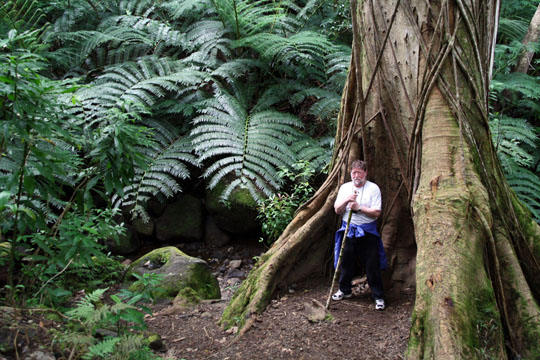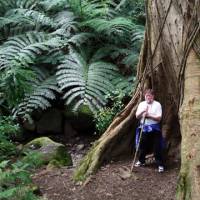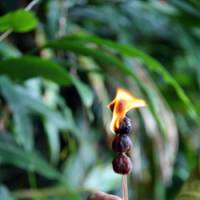Although there was very little snow this winter here where I live in the Nagano Prefecture hills, it was still good to have an excuse to get away from the cold, and the excuse this time was to present a prize for the writer and illustrator of a book for little children.
I head a team that selects works, from both adults and children, and in English or Japanese, to be published as handy little booklets distributed to children on All Nippon Airways international flights. When we make our selections we have no idea who the children are or where they're from. So, it wasn't until we'd made our decisions that we found out that the winner and runnerup were a brother and sister, named Jarrell and Jessica; delightful young kids with an American father and a Japanese mother whose work had been submitted through the Hawaii Japanese School in Honolulu.
That meant I had to go to Hawaii's Oahu Island to present the prize and give an illustrated talk about our Afan woods here in Kurohime to about 400 Japanese and Japanese-American children aged from 6 to 13. It was one of the most interested and responsive audiences I've ever had the pleasure of addressing. They reminded me of how Japanese children used to be about 40 years ago. Pictures of flying squirrels, foxes, dormice, bears and especially of bear poo were a great hit!
Whenever I go somewhere, I try to make time to get out into nature there as well. This time, Mr. Watanabe from ANA, my manager and I were lucky to have the services of a first-class ecotour guide, Hawaiian-born Kyle Ono. On our first day in Honolulu, Kyle met us early in the morning and drove up the Tantalus Drive to the head of a foot trail through the Honolulu Forest Reserve, a lush rain forest overlooking Honolulu and Pearl Harbor and sweeping down from the nearly 60-km-long crest line of mountains that are the main watershed area for Honolulu.
As we got out of the vehicle and prepared to walk, I was amused to see a couple of small feral chickens — a gaudy cock strutting around his brownish hen. These, in fact, are descendants of jungle fowl that ancient Polynesian seafarers brought with them, along with their dogs and pigs. I fumbled with my new camera, but the birds obviously didn't want things pointed at them and ran off into the dense undergrowth.
The trail was narrow and the forest lush and unfamiliar. Kyle stopped along the way to tell us not only the names and origins of trees and plants, but also their traditional uses. In this way he is like an older version of our forester in Kurohime, Mr. Matsuki.
Hawaiian nature is unique. After the volcanic islands began to be formed some 27 million years ago, wind, waves and birds began to bring the first seeds, at a rate of about one species every 100,000 years. With no competition, many of these have evolved and adapted in various ways. From 275 original plant species, with some dividing again, about 300 evolved to be unique to Hawaii.
Ancient Polynesians first came to the islands about 1,500 years ago, bringing with them in their great double-hulled canoes 23 species of plants, including nine trees. These included the hibiscus, coconut palms, Indian mulberry, paper mulberry, breadfruit, mountain apple and the kukui (Aleurites moluccana), or candlenut tree. They also brought banana and bamboo (not exactly trees), as well as various food plants such as taro, which grow in wetland, like rice, and yams and sweet potatoes for dryland fields.
With these trees and plants, and also the original species, a superb culture developed, with the plants giving them construction material, fibers to make cloth and cordage, fuel, tools, utensils and weapons, foods, medicines and dyes.
For me it was the first time to see the kukui, Hawaii's state tree, which has clusters of small white flowers with yellow centers, and large leaves that look a bit like sycamore. Kyle had brought some of the round nuts, which when dried are spiked onto slivers of bamboo to make candles. These nuts are very oily, and burn with a clear yellow flame. They are also called "one, two, three" nuts because just a tiny part of one, chewed and swallowed, gives almost instant relief from constipation.
Following the ill-fated expedition of Capt. James Cook, the royal navy explorer, navigator and cartographer who was killed on the beach in a fight with Hawaiian warriors in 1779, links to the outside world were forged and many more species of plants, animals, birds and insects came to the Hawaiian islands — many beneficial, many not.
During the walk, Kyle showed us coffee growing wild, and we rested for chilled tea in a grove of cinnamon trees, both among the many imported plants that have gone wild. The lovely, flutelike warbling of the White-rumped shama, an imported thrush with a black head and bright orange belly, mingled with the more familiar song of the Japanese bush warbler. The mixture was almost bewildering, but still very lovely.
Our guide had a wealth of information, but it is my habit when visiting another country to look for books on the local flora and fauna, and a couple of days later I found a magnificent volume, titled "Sublime Beauty" by Jim Wageman, that splits the trees and treelike plants into three groups: endemic indigenous, Polynesian-introduced, and postcontact.
Remembering the walks and talks we had with Kyle I was able to leaf through the book and find some that we had been shown in the wild, including several of the huge number of trees that had been brought to Hawaii since the times of Cook, including mangoes, papaya, litchi, cacao, guava, grapefruit, jackfruit, figs, cashew, tamarind and others for food, mesquite for its nectar, livestock feed and charcoal, ironwoods from Burma, frangipani from South America, baobab from Central Africa, Australian flame trees, Cuban royal palms, mahogany, Cook pine, calabash trees from Mexico, monkeypod and bo tree and many, many others I'd never before heard the names of.
The policy of our woodland trust is that we nurture, grow and trim trees and plants native to our area, with just a few special places set aside to grow a few exotics on an experimental basis. We have a few English oaks and Lebanese cedars, for example, both of which are useful for illustrating minilectures on the history of forest use throughout world cultures. There are purists who would have us uproot even these. Such folk would have an awfully hard time adjusting to Hawaiian forests!
Another very important lesson from Kyle was not to linger under some of the huge trees that appeared to be hardy old veterans, hundreds of years old, but were, in fact, swift-growing imports aged about 80. Such trees have the nasty habit of suddenly dropping huge branches, some of which have caused fatalities. Which goes to show that if you are going into forests that you are unfamiliar with, it's best to have a good local guide.





















With your current subscription plan you can comment on stories. However, before writing your first comment, please create a display name in the Profile section of your subscriber account page.